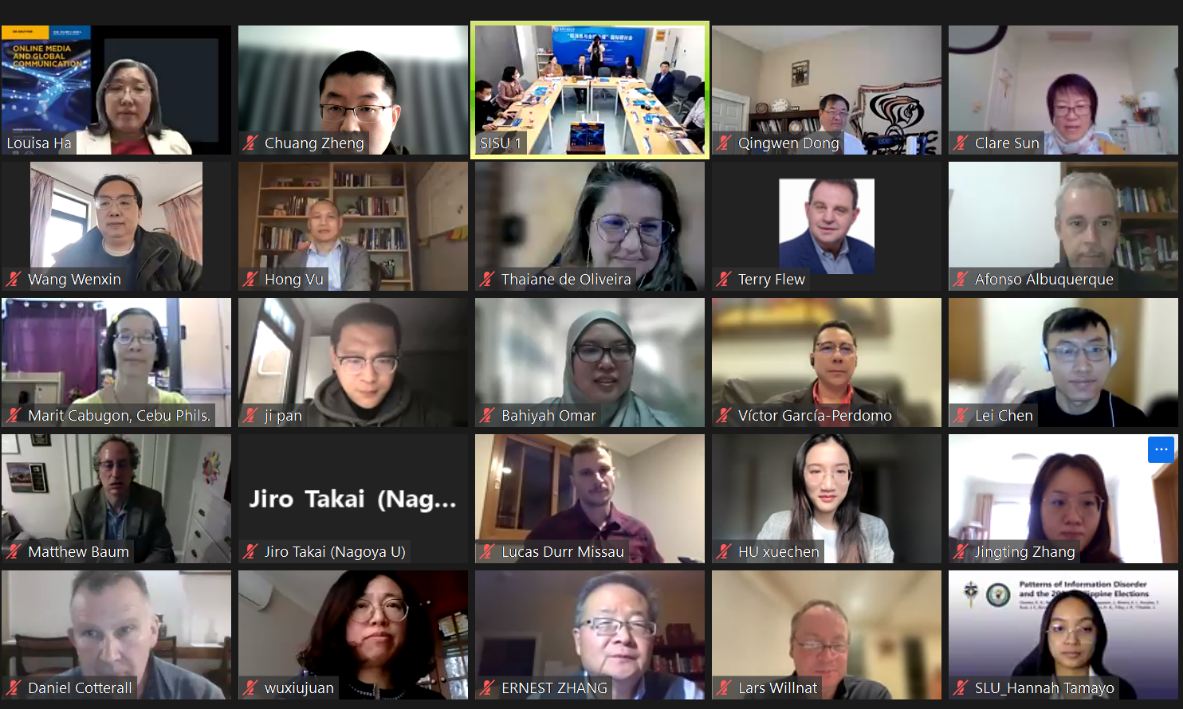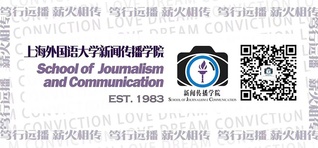Int’l scholars discuss misinformation, witness academic journal debut in SISU
More than 200 scholars and media practitionersfrom China and abroad on Saturday attended an online symposium held by Shanghai International Studies University (SISU) to discuss misinformation and global communication in the digital media environment.

On the sideline of the event, the inaugural issue launching ceremony of the De Gruyter-published academic journal “Online Media and Global Communication” (OMGC) was held.
The English-language journal, sponsored by the Center for Global Public Opinion Research of China and School of Journalism and Communication of SISU, aims to provide a highly accessible platform to users worldwide, through its structured abstracts for all research articles and uniform keyword system in the United Nations’ official six languages (Arabic, Chinese, English, French, Russian, and Spanish).
iang Feng, Chair of the SISU University Council, said in his opening address that academic exchange of journalism and communication plays a positive role in pursuing community with a shared future for mankind and hope the symposium can help address the increasing challenge of misinformation.

The symposium consists of two keynote speeches and six parallel panels in two online conference rooms, with 23 presenters form more than 10 countries and regions.
Keynote speaker Matthew Baum, a professor with Harvard University and the co-founder of HKS Misinformation Review, proposes building a science of misinformation and shared his five-step process, such as convening researchers, practitioners and platforms and publishing a call to action.
The other keynote speaker, Professor Verica Rupar with Auckland University of Technology, argues that locating journalism in relation to civil society provides a suitable catalyst for rethinking journalism surviving the age of misinformation.
The Panel I focused on “Fact-Checking and Fake News”. Lucas Durr Missau from Federal University of Santa Maria showeda high level of standardization of fact-checking models and the related initiatives in Portuguese countries. He also provided financing strategies that “there is still a great deal of funding coming from investors”.
Postdoctoral Associate Chau Tong at Cornell University presented his research about misinformation on covid-19, which investigated two important aspects of fact-checking practices including transparency and accessibility on the one hand, and examined fact-checked claims regarding COVID-19 and provided a snapshot of misinformation on the other hand.
Regarding the Chinese news credibility in the global context, Professor LUO Ziwen at University of Chinese Academy of Social Sciences, shared his research results about fake news characteristics from 2001 to 2020. He said more fake news stories focused on politics, sports, and entertainment, but limited topics in social life, science and education. Many inaccuracies showed up in paper and online media, but few inaccuracies were seen in radio and television programming.
The topic of Panel II is “theorizing misinformation”. Hyelim Lee, Doctoral Student at University of Oklahoma, shared her paper about duality of conspiratorial thinking amplification. She proposed that people with the high trust level towards two politically different administrations, such as Trump and Biden in this case, will increase their conspiratorial thinking about political issues. The active information behavior is effective to both partisans’ conspiracy thinking of the social issues, yet in a dissimilar manner.
Jeong-Nam Kim Professor at University of Oklahoma presented his recent work about underground information market and the problem of the info market failure. In the digitized marketplaces of ideas, lay people’s cognitive modus operandi tends to be retrogressive(from conclusion to evidence), which leads to cognitive retrogression in problem solving. A key finding showed that motivated pseudo-information trafficking is likely when cognitive problem solving is constrained. And the growth of user-generated contents was the main social influence in the information market.
Professor Joseph P. Zompetti at Illinois State University said in his speech about social media algorithms manipulating data to spread disinformation. From perspectives in rhetorical theory, spectacle, digital literacy, and social media data analysis, they use an interdisciplinary approach to explore negative vaccine-related messages. He presented the theoretical 4D model of disinformation, dismiss, distract, dismay through the research. Student Michael Severino and Hannah DeLorto talked about the role of algorithms, bringing anti-vax examples in terms of the twitter, Instagram and tiktok platform.
Discussant Hong Vu, Associate Professor at University of Kansas, appreciated all the presenters’ work and the research design of the paper. And he raised few of his questions such as the three political issues and the number of variables, some overlapping between participants political ideology and require more clear differentiation about some concepts.
The Panel III discussed fake news causes and effects. SISU Graduate Student Meng Qianyu took the Third-Person Effect as theoretical guide and found that topic involvement positivepredicts third-person effect. COVID-19 fake news involving negative contents have a stronger third-person effect than fake news with positive contents.
Zhao Yonghua, Professor at Renmin University of China, talked about his qualitative analysis on causes and generation mechanism of international fake news. Taking 32 cases of international fake news from 1995 to 2021 as the research samples, he found two typical paths —— covert and overt ways for the generation of international fake news. He also advocated that international journalist should become agents in the global public sphere.
Graduate student YANG Hanye from Chinese University of Hong Kong brought her comparative study of fake news, discussing the causative factors, the measures at the legal level and the challenges in the process of countering “fake news”.
SISU Assistant Professor Lv Nan talked about fact-checking and international reporting innovation. International news was regarded as luxury content product in the digital media era. She identified high production cost, such as language barriers, and high sense-making cost, including the lack of relevance with the local audience and the lack of education.
Panel IV was about social media and COVID-19 misinformation. SISU doctoral student Xiong Mingli said social media greatly facilitate speedy exchange and spread of information. She conducted a bibliometric analysis of research on misinformation in social media by using a collection of database and different tools. The analysis found that authors from United States, England, China, Australia, Spain, Canada, Germany, Italy, Singapore and Netherlands have made most of the contributions in this area
Han Quanzheng, a graduate student from Tsinghua University, said the social media search engine has data voids, which impact the authenticity and objectivity of information acquisition. His study took Sina Weibo as the research object, used social network analysis and content analysis, from the perspective of information behavior theory.
Assistant Professor Su Yan from Peking University said the “infodemic” aroused homogeneous online discussion, self-perceived media literacy and COVID-19 misperceptions. People easily held false belief. He showed a moderated mediation model that social media use is positively associated with misperceptions about the COVID-19. Homogeneous online discussion was regarded as a significant mediator in people’s cognitive processes.
Associate Professor Angela Chang from University of Macau delivered her speech about COVID-19-vaccine debate by Examining Super-Spreaders’ Lies. By using a content analysis method, international news media data were crawled, including CNN, New York Times, and Reuters covered the high-profile doctors for spreading COVID-19 vaccine lies. Her student Mary Tzu-I Ho from National Taiwan University specified a few examples of super spreader case analysis.
The Panel V was about “Solving the Misinformation Problems”. Gao Bowen, Assistant Professorat Soochow University, conducted a social experiment to test the effect of different methods of education on students questioning possibly forged media content by deepfake technology. His finding turned out that trust in news information value of participants in one experimental group went significantly down, along with their deep reading capability.
Associate Professor Liu Yusi compared the levels of post-pandemic resilience of the hybrid media systems to problematic information across 40 countries. Their Initial analysis showed two possible paths to high resilience to problematic information. One is to open media criticism and free public discussion under the regulation of Internet law. The second path is to restrict the freedom of media criticism or public discussion in the absence of legal protection of online speech.
Associate Professor Pan Wenjing from Renmin University of China conducted an online survey study on 22706 Tencent News users regarding their food safety misinformation acceptance. Their result showed that food safety misinformation exposure positively predicted misinformation acceptance via perceived threat to food safety issues.
Aishik Saha, a graduate student from Jadavpur University, presented her study about the conceptualization of Digital Labour. Misinformation was labeled as “Disorderly Capital. The perspective from the studies of Digital Labour was proposed to be incorporated in the field in the further analysis.
The last Panel was “Misinformation and Global Politics”. Li Xuan, a PhD student at People Friendship University of Russia, took the case of disinformation against Russia as an example and said that disinformation has been widely used as an information warfare tool since the Cold War. By identifying disinformation to strengthening the overall resilience of societies against these threats, "disinformation" has gradually become a labeling tool to expose propaganda, which meanwhile decline the public trusts in the media and the country that publishes the information.
Liu Bei, a doctoral Student at Tsinghua University, said most of the political issues of the developing countries are not included in the general interest of international politics. They took the case of the Srivastava group in India, which has built up a huge media empire with fake European authoritative media identities. Their study showed some enlightenment from the practice of India for other developing countries: firstly, the current international communication order is still dominated by developed countries, and secondly, grasping the access point of agenda-setting may be an effective way to intervene in international communication.
Professor Janet S. Tibaldo and his other 11 fellows from Saint Louis University discussed the Patterns of Information Disorder and the 2022 Philippine Elections. The Philippines will elect a new set of national and local officials in May 2022. Using descriptive content analysis, their study surfaced the dominant patterns of information disorder in the 2022 Philippine Elections. They examined fact-checked media texts about five presidential candidates as well.
Luiz Peres Garzezi and Amparo Huertas-Bailén, scholars from Autonomous University of Barcelona, explained their research about sinophobia, hate speech, and right-wing disinformation in Spain. In the covid-19 context, the extreme right-wing political party VOX has engaged with disinformation and hate messages linking China with the Covid-19. They have conducted critical discourse analysis to extract the macro propositions and their discursive implications.
In the closing remarks, Guo Ke, dean and professor of School of Journalism and Communication of SISU, expressed hope of building an academic community of misinformation study to produce more quality researches.

 |Hongkou Campus|550 Dalian Road (W), Shanghai 200083, China |Songjiang Campus|1550 Wenxiang Road, Shanghai 201620, China
|Hongkou Campus|550 Dalian Road (W), Shanghai 200083, China |Songjiang Campus|1550 Wenxiang Road, Shanghai 201620, China